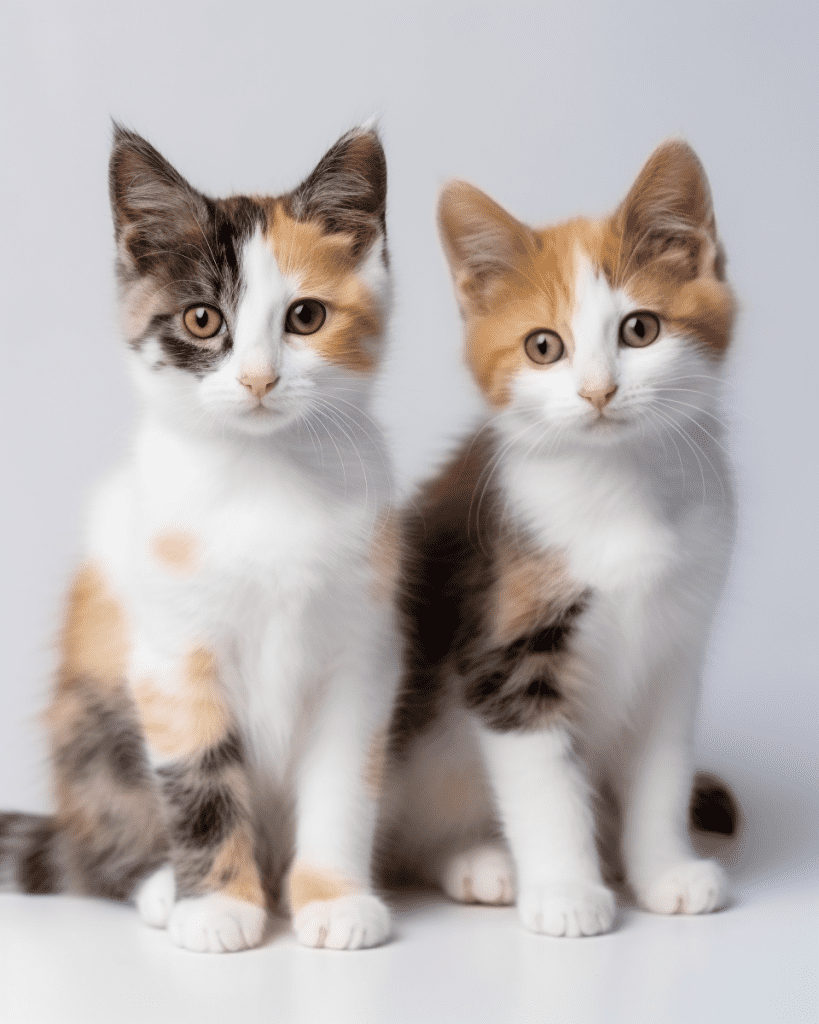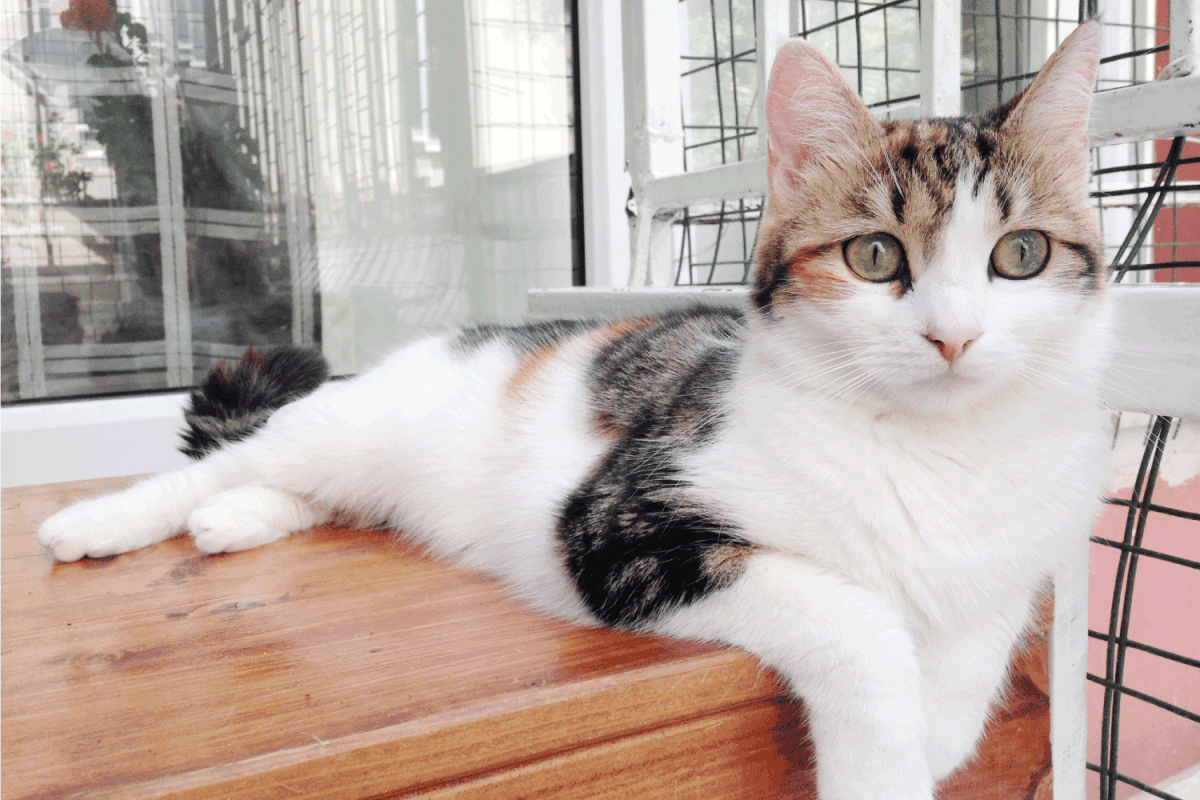When it comes to your calico cat's health, you might wonder if their unique coat pattern is linked to any health issues.
The good news is that, in general, calico cats do not have more health problems than other cats.
However, there is an exception, and we'll cover that later in this article!
We'll also review the genetics of calico cats to get a better understanding of that exception, so keep on reading to become a calico expert!

Understanding Calico Cats
Genetics of Calico Cats
Calico cats are not a breed, but a unique color pattern made up of orange, black, and white patches on their fur. Their distinct coloring comes from their unique genetic makeup.
Female cats have two X chromosomes (XX), and males have one X and one Y chromosome (XY).
The colors orange and black in a cat's fur are carried on the X chromosome. Since female cats have two X chromosomes, they can carry both orange and black fur genes, allowing for the possibility of the calico pattern.
Male cats usually have only one X chromosome, which means they can only carry either the orange or black gene, but not both.
Rare male calico cats carry an extra X chromosome (XXY), a condition known as Klinefelter syndrome.
We'll talk more about the health problems of male calicos in a bit. First, let's try and better understand the calico pattern.
Origin and History
Calico cats have been admired for their striking colors and patterns throughout history.
These cats are believed to have originated in Egypt and then spread to Europe and Asia.
The term "calico" comes from the resemblance of their fur pattern to the calico fabric, which was first produced in the city of Calicut, India.
When looking for a calico cat to adopt, remember that their unique coloring can be found in various breeds of cats, such as the American Shorthair, British Shorthair, and Persian.

To find a calico cat or kitten, check with local shelters, breeders, or online adoption sites.
General Health of Calico Cats
If you have a female calico, you have not thing to worry about. Your calico cat is generally healthy and doesn't necessarily have more health problems than other cats.
In general, your calico cat should enjoy a long, healthy life, especially if you provide proper nutrition, regular veterinary check-ups, and a stress-free living environment.
Always be attentive to any changes in your cat's behavior or appearance, as these could be signs of an underlying health issue.

Dispelling the Myth of Increased Health Problems
As an owner or admirer of calico cats, you might have heard the rumor that these colorful felines have more health problems than other cats. Fortunately, this myth can be debunked.
In general, calico cats are just as healthy as other domesticated felines. Regardless of their fur color, most calico cats grow to be normal and healthy pets with no significant increase in health risks compared to other breeds or coat patterns.
We'll talk more about how to keep your furbaby healthy throughout her life, but first, let's address the exception to the rule:
The male calico.

In all likelihood, the rumors about health issues in calico cats stem from the fact that the - very rare - male calicos can potentially face more health problems.
Specific Health Concerns for Male Calico Cats
While female calico cats don't have any extra health problems, it is essential to understand the unique health concerns that can arise for rare male calico cats.
Klinefelter Syndrome
Remember how we said that male calico cats possess an additional X chromosome in their genetic makeup? The result is an XXY pattern rather than the standard XY pattern found in most male cats.
This anomaly is known in humans as Klinefelter Syndrome. Technically, it's not the accurate name for the same phenomenon in felines, but it's so similar that many people use it for cats as well.
As a result of this genetic difference, male calico cats may experience several particular health issues, such as:
- Increased risk of heart disease
- Higher likelihood of developing diabetes
It's important to note that these health concerns do not necessarily mean male calico cats will have a short life.
With proper care and management, they can still lead a fulfilling life. However, male calico cats may require additional treatment and close monitoring to address the potential health risks associated with Klinefelter Syndrome.
Maintaining Your Calico Cat's Health
Although calico cats generally do not have an increased risk of health problems, it's still essential to take proper care of your feline friend.

In this section, we provide tips on maintaining a healthy calico cat, focusing on proper nutrition and regular veterinary care.
Proper Nutrition
Your calico cat's diet plays a crucial role in maintaining their health. Ensure that you feed them a high-quality, well-balanced diet that meets their nutritional needs. This typically includes:
- Protein from animal sources such as chicken, beef, or fish
- Fats for energy and a healthy coat
- Vitamins and minerals to support overall health
Remember to provide fresh water at all times, and tailor their diet according to their age, activity level, and any specific health concerns they may have.
Consult your veterinarian for personalized recommendations on the best food options for your calico cat.
Regular Veterinary Care
Regular check-ups play a vital role in keeping your calico cat healthy. Schedule appointments with your veterinarian at least once a year, or more frequently for kittens and senior cats.
During these visits, your vet will:
- Perform a thorough physical examination
- Check for any signs of illness or underlying health issues
- Administer necessary vaccinations
- Recommend any needed dental care, grooming, or other services
Be vigilant about any changes in your cat's behavior or appearance, and consult your veterinarian if you notice anything concerning.
Early detection of health problems may lead to more effective treatment and help your calico cat live a long, healthy life.
How Long Do Calico Cats Live in Human Years?
Both Web MD and the American Society for the Prevention of Cruelty to Animals (ASPCA) agree that the ordinary cat may live 15 years or more with a good diet and regular veterinarian treatment.
Calicos aren't a breed and are a complex color pattern seen in many cat breeds. Like any other cat, female calicos have a life expectancy of about 15 years if properly cared for. But male ones aren't as fortunate.
What Is the Average Weight of a Calico Cat?
Just like cats of other colors and patterns, the weight of a calico cat varies. Some of these cats can become obese, affecting their size.
Feel the calico's body and ribs to see whether she's overweight. The fat on an obese cat's body prevents you from feeling her ribs, whereas a starving cat's ribs are thin or nonexistent.
Obese cats have a spherical form with no discernible waist below the ribs. A healthy cat's tuck indicates a waistline.
A normal-sized calico cat weighs between 7 and 9 pounds, but an obese one weighs much more and needs a commercial diet. Obese cats, like overweight humans, are more prone to diabetes, hypertension, arthritis, heart disease, and some cancers.
If you suspect your calico cat may be obese, talk to your veterinarian for professional assessment and care advice.
So, What's the Verdict on Calico Health?
When it comes to the health of your calico cat, you don't need to worry too much about them having any more health problems than the average cat.
The majority of calico cats are female, and they typically don't experience any health issues directly related to their unique color pattern.
Each cat is different, and any health issues they encounter are usually breed-specific rather than color-related.
However, if you happen to have a rare male calico, they may be more prone to some health problems due to having a genetic anomaly.
It is important to note that these health risks are relatively rare, and many calico cats, male or female, can lead long and healthy lives.
If you're a proud calico cat owner or are considering adopting one, remember that their overall health has more to do with their breed and proper care than their striking color pattern.
Like any cat, calicos deserve love, attention, and consistent veterinary check-ups. So, make sure you're providing your calico companion with a healthy lifestyle and enjoy their unique beauty!
Calico lover? You may also find the following articles interesting:
Do Calico Cats Change Color As They Age?
Some elements on this page may have been created by our team using advanced AI to provide you with top-notch cat inspired ideas. Read more about our AI Content Policy.
